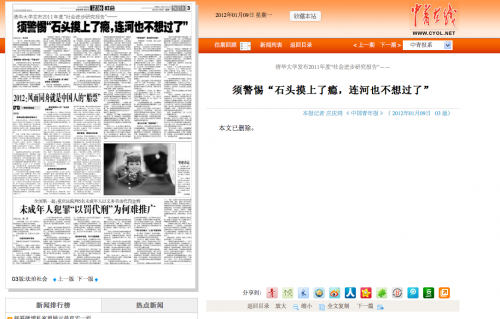On January 9, the Social Development Task Group of the Sociology Department at Tsinghua University released its 2011 “Research Report Series on Social Progress,” in which it warned that “powerful vested interests” in China were now “holding reforms hostage.” The report, authored by sociology professor Sun Liping (孙立平), the former doctoral adviser to now vice-president and successor apparent Xi Jinping (习近平), argued that China was in the midst of a “transition trap” (转型陷阱) in which the energy and impetus to push ahead with necessary reforms was being lost.
A lengthy summary of the Tsinghua University report was published in the January 9 edition of China Youth Daily, and was quickly posted to a number of major Chinese web portals, including People’s Daily Online. But within hours, links to the article were disabled.
By mid-day the link to the China Youth Daily version at People’s Daily Online called up a warning page that read: “The page you are looking for does not exist. You will be automatically re-directed to the People’s Daily Online homepage in 5 seconds.” A similar warning from the popular Netease web portal read: “We’re sorry, the page you are visiting does not exist or has already been deleted.”

For several hours, users on the popular social media platform Sina Weibo shared a link to a cached version of the China Youth Daily report at Baidu.com, as well as news that the article had been deleted from sites like Netease. By day’s end the Baidu version had been pulled down as well. The page now linked only to the electronic edition of China Youth Daily, where an unreadable image of the original newspaper page could be found but the text to the right only read: “This article has been deleted.”

The China Youth Daily article, mostly a stringing together of various quotes and passages from the report, was a challenge to translate under time constraints — but we offer our version here with the hope readers will find it helpful and informative. We have also pasted the Chinese under the translation.
We welcome any comments and/or clarifications on translation, as well as other observations and context. Please contribute these in the comments section at the bottom of the page.
“We Must Be Alert to ‘Becoming Obsessed With Feeling the Stones, to the Point Where We Don’t Want to Cross the River Anymore'”
China Youth Daily
January 9, 2012
“Today, system reforms have already become mired in difficulties. This, it can be said, is an undisputed truth. In recent years, a number of important reform measures have been shelved, and political reform has failed to move forward.”
Released today by the Social Progress Research Institute of Tsinghua University’s Kaifeng Development Research Center, and by the Social Development Task Group of the Sociology Department at Tsinghua University, the end-of-year 2011 “Research Report Series on Social Progress” points out that what our country most needs to be alert to right now is the “transition trap” (转型陷阱).
Transition Trap: Midway Through Reforms, “Not Wishing to Cross the River” (“不想过河”)
One decade into the new century, domestic observers say that “the disposition of Chinese society is changing”; Some people think that reforms have already ended, already died. “If we say that the 1980s were characterized by reform, and the 1990s were characterized in the first half by reform and the second half by opening, then in the latest 10 years stability preservation has become the defining tone,” [says the report].
What is going on here? Lately there have been two explanations. One holds that China has struck upon the middle income trap that developing nations have experienced before. Another holds that reforms have stalled or are even rolling back.
This report, whose chief author is Professor Sun Liping (孙立平) of Tsinghua University’s Sociology Department, points out that what China most needs to be alert to right now is the “transition trap.”
The “transition trap” refers to the creation in the process of reform and transition of powerful vested interests (既得利益集团) that obstruct further reforms, demanding that the prevailing system of the transitional period be firmly established in order to create a “mixed system” (混合型体制) maximizing the benefits [accruing to the vested interests], an eventuality that would result in the malformation of social and economic development and the accumulation of economic and social problems. “It is like an inferior and temporary shelter that people then re-decorate. They set up a makeshift kitchen, get married, have children. The residence becomes their world [despite its slapdash nature].”
The report argues: “In the past, we have placed too much emphasis on the advantages of gradual reform. But looking [at the situation] now, there is much greater risk of a country gradually reforming sinking into the transition trap. This is because gradual reform presents more opportunities in the process of transition for stalling and for hardening [of institutions] (定型化), and the conditions are more conducive to the emergence of powerful vested interests.”
[The report argues further that:] “Actually, the challenges facing reform in China today are not as they have been described by some, who say that, ‘Reform has entered a deep zone, in which [further] reforms cannot get off their feet.’ In the early days of reform, raising [the metaphor of] ‘crossing the river while feeling the stones’ was a realistic choice. But the problem today is that we’ve become so obsessed with feeling the stones that we don’t even wish to cross the river anymore.”
Taking Stock of Five Major Symptoms: Using the Excuse of “Stability Preservation” to Avoid Reform
The report analyzes “five major symptoms” of the transition trap. The first symptom is the growing ponderousness and constant malformation of economic development.
The report points out that the most real problem in China’s economy right now “is not stagnation, but rather development that is hyperactive (畸形) and malformed (畸形).” On the one hand, the potential provided by the development of backward regions, industrialization, urbanization and other factors is still there. On the other hand, nature of China’s political system gives the government powerful latitude in combating the slowdown of economic growth.
Within the pattern of the transition trap, the situation for private enterprises and particularly small and medium-sized enterprises is difficult, and the private impetus (民间动力) for economic activity goes down. This means there can only be greater and greater reliance on the government to drive the economy forward, which means demolishing buildings everywhere and rebuilding (大拆大建), holding large-scale events (办大活动), constructing huge buildings (盖大高楼), building huge plazas and squares (修大广场), and even erecting big statues (造大塑像).
The report refers to this as “incremental capital over-dependency” (增量依赖症): “In the transition trap, major system reforms have not been relied upon to resolve problems, and so the only answer is to rely upon enlarging the cake, using incremental capital from development to relieve problems, under the precondition of not touching powerful vested interests.”
Under this sort of incremental capital over-dependency, the people may not necessarily benefit from economic expansion; but if there is no growth, the people will suffer damage as a result.
The second symptom is that institutional factors in the transitional period become hardened.
Quite surprisingly, the report points out that “loss of momentum in reforms is not merely a question of the reform-minded wishes of the leadership classes, but an issue of doubts already emerging among the masses about reform.”
“If it were the case that the people demanded continued reform and powerful vested interests resisted and opposed them, then the situation would perhaps be relatively simple,” [the report says]. The report goes on, “The problem is that powerful vested interests have caused reforms to become deformed and lose their shape, and they have sought to enrich themselves in the name of reform. This has engendered antipathy toward reform among the people. Just like we can see in our daily lives, that now as soon as anyone starts talking about reform ordinary Chinese get jumpy. So the result is not only that real efforts to reform are constrained, but that the whole notion of reform has fallen out of favor.”
For example, in the midst of healthcare reforms in a number of regions unreasonably high prices for medicines have been brought down and the cost of medical care itself correspondingly raised in order to do away with over-reliance of the medical profession on expensive prescriptions. But after a period of time, the prices of medicines shot up again, with the result that the previous situation of low-cost medical care and high-cost medicines became a system of high costs across the board, and the burden on patients went up.
The third symptom is the trend toward hardening of the structure of society, hardening into a fractured society “stratified into rich and poor.”
The report cautioned that most in need of attention was the current social atmosphere or social psychology: First, as the thresholds in society had been raised [for access to all manner of benefits, etc.], society has seen a substantial drop in vigor and vitality. Second, the sense of opposition between various levels of society is now pronounced, and the collective sense of “hatred for the rich” (仇富) or “disdain for the poor” (嫌贫) were on the rise. Third, an ordinary sense of imbalance has been replaced among a portion of people with a sense of despair. “For example, among farmers, migrant workers and those at the lower rungs of society, there is a sense of despair and hopelessness. The intensification of some social tensions is inevitably related to this.”
The fourth symptom is an overcautious mentality and policies oriented toward “stability preservation”, which is rooted in misjudgment over social tensions and conflicts.
“In recent years, social tensions have shown a clear increasing trend. It should be said that there are many tensions that can arise as a matter of course in a market economy, and of these the vast majority do not constitute a serious threat to political power or to basic institutional frameworks. But in recent years, relevant parties [i.e., political leaders] have made a serious miscalculation [in assessing threats to basic stability], resulting in a fantasy of instability.”
The regime of “stability preservation” [in China] has emerged on the basis of this reading of the situation. Big or small, it lumps all matters together under the prerogative of stability preservation, “mobilizing the resources of society for an all-out campaign of stability preservation, taking special [extreme] measures meant for special [extreme] situations and normalizing them, systematizing them, with the result that the political, social and economic life of our nation has been thrown in a [chronic] state of ab-normalcy.”
The report points out that using “stability preservation” at a rationalization for not carrying out substantive reforms is classic “transition trap” logic. The ultimate outcome of the rigid thinking of stability preservation and the massive stability preservation project is in fact the intensification of social tensions, and it even takes a number of tensions arising normally from daily life and transforms them into doubt and resentment toward the system [as a whole].”
The fifth symptom is an ever more salient sense of social defeat. “This is seen first and foremost in the way government power in some local areas is out of hand, [for example] the violent interception of petitioners (暴力截访), violent [property] demolition and removal [of residents] (血腥拆迁). The direct result of runaway power is the decline of the society’s ability to preserve fairness and justice. As a result, loss of bottom line social [standards], slipping morality, the loss of professional conduct and professional ethics have become extremely common phenomena.”
How Did the “Transition Trap” Emerge”?
The report points out that [the “transition trap”] is the special product of the odd alliance between power and the market. “[The “transition trap”] is often [seen in] the alternate and combined use of power and market means, turning to power means when power means are convenient, and turning to market means when market means are convenient.”
According to the report’s analysis, in the process of the emergence of powerful vested interests, [abuse of power through] the following processes play important roles: “official profiteering” (官倒) [in which Party or government organs engage in profiteering activities against the regulations of the State Administration of Industry and Commerce], restructuring of state-owned enterprises, the exploitation of coal and other resources, land development, property speculation, public listing of enterprises . . . [Through these activities] powerful vested interests quickly come to dominate land, mining, financial resources, basic infrastructure nationwide, urban development, public works projects, the development of rural water projects as well as energy, electrical power, telecommunications, manufacturing and other important industries.
“The so-called China Model is a development model derived from this sort of system. [It is about], in the context of strengthening [government] administrative capacity, taking a market system and shattering it into market factors, then using power to reorder these market factors in order to achieve a high degree of monopolization of resources.”
The report also analyzes the chaotic nature of the debate lately between the intellectual “left” and “right.” “For a number of years, in fact, people have been habituated to viewing the market and power as two things in wide opposition, as being inversely related.”
In this context, the “left” can be understood [in the simplest terms] as [a sense of] alertness to the “market” or “capital” factors within this [above-mentioned] mixed system, while the “right” can be understood as sensitivity to “power” factors. Put another way, the “left” advocates for factors of “power” while the “right” advocates for “market or capital” elements.
“Before the transition trap is broken through, either [camp of] advocates might be used by powerful vested interests, turned into means by which their interests can be maximized.”
As people are debating over whether the transition to the market economy has gone far enough or too far, the connection between non-market power and maketized products has become the most effective means by which [vested interests] can profit. “For example, [officials] can obtain land at a cheap price through administrative means and then turn around and sell it for a high price on the market. Is there anything more valuable than this [method] to powerful vested interests in the amassing of wealth?”
The report argues that the actual impetus of social change [in China] has already grown weaker and weaker. “The transition trap can become a ‘snare’ because at this time the [status-quo] system has already made detailed preparations to repress change, the monopolization of resources grows more and more serious by the day, vested interests are expanding, and society is more and more tightly controlled. This doesn’t mean, however, that there is no longer any impetus in society for change.”
“Lately dissatisfaction with the stalling of reforms has increased, and demands for change are coalescing. In addition, as groups who benefit from vested interests are shrinking, many segments of the population are being shut out [from the benefits of development]. These both provide potential impetus for change, but the problem is how to transform this potential impetus into real impetus.”
The report argues that there are three roads out of the “transition trap”: the first is the government carrying out top-level [institutional] design, and promoting these [institutional reforms] with sufficient strength; the second is to use existing potential factors to promote the development of social forces (社会力量), using these social forces as an impetus to break through the status quo; the third is passive change in the midst of tensions and crises, “but this depends upon the self-examination and consciousness of vested interests.”
Regardless of which path is taken, there are four measures, according to the report, that are “unavoidable”:
1. “[China must] move in the direction of the mainstream world civilization.” The report holds that the “mainstream world civilization” has as its core values “freedom, rationality, individual rights, market economics, democratic politics and rule of law.”
2. “Recreating social vitality through political reforms.” “Political reform and social construction (社会建设) offer the most practical impetus [means] of moving out of the transition trap.” The report argues that resolving the problem of black case work (暗箱操作) [or behind the scenes dealing], and promoting the open operation of power, creating mechanisms to check power (制约权力的机制), can serve as the breakthrough points for political reform (政治体制改革的突破口). In recent years, the central party has already promoted open government information (政务信息公开).
3. Carrying out reforms in terms of top-level [institutional] design on the basis of public participation (民众参与). “In fact, one of the most important reasons that reforms have taken a malformed path in recent years is a lack of participation in reform by the masses. In the 1980s reforms were supported by the enthusiasm of an idealism [in society], and the defect of inadequate public participation was not yet so readily apparent. But once this idealism faded, interest [self-interest, the profit motive, etc.] became the chief factor driving reforms. Reform, in the absence of public participation, can quite easily become a large-scale dividing of the spoils (大规模的‘分赃’). Many clear examples of this could be seen in the restructuring of state-owned enterprises in the 1990s.”
4. Finally, the report advocates using “equity and justice” to form a consensus on [further] reforms. “What people feel most readily in the midst of the transition trap is disaffection, that equity and justice have been destroyed. Therefore, re-coalescing a consensus on reform must be done by defining equity and justice and the most basic value and objective [of reform]. In this sense, the building of democracy and rule of law must be the core content of future reforms in China.”
The report concluded: “In an era like today, what China needs above all else is courage, the courage to face vested interests head on, to break through the fabric of vested interests and through the logic of the ‘transition trap’, the courage to move beyond the present deadlock and morass.”
——————
须警惕“石头摸上了瘾,连河也不想过了”
2012-01-09 03:19 来源:中国青年报
“在今天,体制改革已经陷入困境,可以说是个不争的事实。近些年来,一些重要的改革措施被搁置,政治体制改革尚未进一步推进。”
清华大学凯风发展研究院社会进步研究所、清华大学社会学系社会发展课题组今天发布2011年度“社会进步系列研究报告”,指出我国目前最需警惕的是“转型陷阱”。
转型陷阱:改革中途,“不想过河”
在新的世纪走完10年后,国内的观察家说“中国社会的气质正在发生变化”;有人则认为改革已经终结,已经死亡。“如果说上世纪80年代的特征是改革,90年代的特征前期是改革后期是开放,而最新的这10年,维稳则成了最基本的基调。”
这究竟是怎么回事?目前流行的有两种解释。一种是认为出现了发展中国家经历的“中等收入陷阱”,另一种认为是改革处于停滞甚或倒退状态。
而这份由清华大学社会学系孙立平教授主笔撰写的报告指出,中国现在最需要警惕的,不是上述两者,而是“转型陷阱”。
“转型陷阱”指的是,改革和转型过程会造就一个既得利益集团,这个集团会阻止进一步变革,要求把过渡时期的体制定型化,形成使其利益最大化的“混合型体制”,由此导致了经济社会发展的畸形化和经济社会问题的不断积累。
“这就如同在一幢烂尾的大楼中,人们简单装修一下就搭灶做饭,娶妻生子,也俨然成为一片天地。”
报告认为:“过去,我们过多地强调了渐进式改革的优势,但现在看,一个渐进式改革的国家陷入转型陷阱的危险会大大增加。因为在渐进中,使转型过程停滞并定型化的机会太多,既得利益集团从容形成的条件更为有利。”
“其实,现在中国的改革困境并非像有些人所说的那样:‘改革开始进入深水区,已经改不动了’。在改革初期,提出‘摸着石头过河’是一种现实的选择,但现在的问题是,可能是摸石头摸上瘾了,连河也不想过了。”
盘点五大症状:用“维稳”的理由,拒绝改革
报告分析了转型陷阱的“五大症状”。第一个症状是,经济发展步履沉重并日益畸形。
报告指出,中国在经济上最现实的问题“不是停滞,而是亢奋、畸形的发展”。一方面,落后地区发展、工业化和城市化的潜力等仍然存在,另一方面,体制决定了 政府“反放缓”、“反停滞”的能力是极强的。“在转型陷阱的格局中,民营企业尤其是中小型民营企业处境艰难,经济活动的民间动力下降,于是,只能越来越依 靠政府推动,大拆大建,上大项目,办大活动,盖大高楼,修大广场,甚至造大塑像。”
报告把这称为“增量依赖症”。“在转型陷阱中,人们没有通过重要的体制变革来解决问题,于是只能寄希望于做大蛋糕,在不触动既得利益格局的前提下,用发展形成的增量来缓解问题。”
在这种增量依赖症中,经济增长了,民众不见得会受益;但如果不增长,民众则会受损。
症状之二是,过渡的体制因素被定型下来。
出人意料的是,报告指出“改革动力的丧失,并不仅仅是领导层的改革意愿问题,而是在民众中已经对改革发生了疑问”。
“如果现在是民众要求继续改革,而既得利益集团在那里阻挠和反对,事情也许还比较简单。”报告分析,“问题在于,既得利益集团让改革走样变形,以改革的名 义获取利益,由此引起一般民众对改革的抵触。正如我们在现实生活中能看到的,现在老百姓一说起改革就心惊肉跳。其结果是,不仅实质性改革受阻,而且这个字 眼都在失去民心。”
比如,在一些地区的医疗改革中,需要降低不合理的高药价,相应提高医疗的价格,改变“以药养医”的现象。但过一段时间,压下去的药价又高了,结果是由过去的药价高、医疗价格低变成两者价格都高,患者的负担进一步加重了。
症状之三是,社会结构趋于定型,固化为“贫富分化”的断裂社会。
报告提醒,值得注意的是现在的社会氛围或社会心态:其一,由于社会中的门槛加高,社会活力大大下降。其二,阶层之间的对立情绪凸显,“仇富”与“嫌贫”的 集体意识在蔓延。其三,普遍的不平衡感为部分人的绝望感所取代。“比如在农民、农民工和城市底层等群体中,存在看不到希望的绝望感。一些社会矛盾的激化往 往与这个因素有关。”
症状之四,就是误判社会矛盾形成的拘谨心理和“维稳”政策导向。
“近些年来,社会矛盾有明显增加的趋势,应当说,一些本来是市场经济中正常存在的矛盾,其中绝大多数并不会形成对政权和基本制度框架的严重威胁。但近些年来,有关方面产生了严重的误判,形成了一种不稳定的幻象。”
在这种判断的基础上,“大维稳”模式形成了。它将社会的大小事都与稳定联系起来,“动员社会资源进行全方位维稳,将一些特殊时期的特殊做法常规化、体制化,使我国政治经济社会生活处于一种很不正常的状态”。
报告指出,用“维稳”的理由拒绝实质性改革,是“转型陷阱”的典型逻辑。“僵硬的维稳思维以及大维稳模式,最终结果往往反而是激化社会矛盾,甚至把一些日常生活中的矛盾演变为对体制的怀疑和怨恨。”
症状之五,社会溃败日渐明显。“首先表现为一些地方政府权力失控,暴力截访、血腥拆迁;权力失控的直接结果,是社会维护公平正义的能力在降低。于是,社会底线失守,道德沦丧,职业操守和职业道德的丧失成为相当普遍的现象。”
“转型陷阱”是如何形成的?
“转型陷阱”下的体制,是怎么逐步定型下来的?
报告指出,它以权力与市场的奇异结盟为特征。“往往是权力与市场手段的交替结合使用,在权力手段方便的时候使用权力手段,在市场手段方便的时候使用市场手段。”
报告分析,在既得利益群体崛起的过程中,下述过程起到了重要的作用:“官倒”、国企改制、矿产资源开发、土地开发、房地产热、企业上市融资……既得利益集 团迅速支配了土地、矿产、金融资源,涉及遍布全国的基础设施、城市开发、公共工程、农村水利建设以及能源、电力、通信、制造等重要行业。
“所谓中国模式,就是在这种体制中派生出的发展模式。在行政能力继续强化的前提下,把市场体制打碎为市场因素,通过权力重组市场因素,实现对资源的高度垄断。”
由此,报告也解析了目前中国思想界“左派”和“右派”争论的混乱。“因为在过去许多年中,人们一直把权力和市场看成是两个截然对立的东西,两者关系是此消彼长的。”
在这种情况下,可以把“左”理解为对这个混合型体制中“市场”或“资本”因素的警惕,将“右”理解为对“权力”因素的警惕。反过来说,“左”是在为“权力”因素呼唤,而“右”是在为“市场或资本”因素呼唤。
“在打破转型陷阱之前,无论哪种呼唤,都有可能被既得利益集团借用,变成完善利益最大化的手段。”
而当人们还在为我国“市场化改革不彻底还是过头”争论的时候,一些权力的非市场化和商品的市场化相衔接,已经成为最有利的牟利方式。“比如从行政上获得廉价的土地和资源,然后再以高价格卖到市场,还有比这种方式更有利于既得利益集团聚敛财富的吗?”
靠什么打破“转型陷阱”?
报告承认,目前变革社会的现实动力已经越来越微弱。“转型陷阱之所以能成为‘陷阱’,就是因为此时的体制已经对遏制变革作出了周密安排,资源垄断日益严重、利益集团坐大、社会控制愈益严密。但这并不意味着社会已经完全没有变革的动力。”
“目前对改革停滞的不满在增加,变革的要求也在凝聚,另外,由于既得利益集团的圈子在不断收窄,许多群体被甩出圈子之外。这都是进行变革的现实动力,问题是如何将这种潜在的动力变成现实的动力。”
报告认为,可能走出“转型陷阱”的道路只有三种:一是由政府实施改革顶层设计,并有相应的力量推动;二是利用现有可能的因素推动社会力量的发育,使社会力量成为打破现状的动力;三是在矛盾和危机推动下的被动改变,“但这要取决于既得利益集团的自省和觉悟”。
不管哪一条路,报告呼吁,有四大措施是“不可回避”的:
首先是,“汇入世界主流文明的方向”。报告认为,这个“世界主流文明”的核心价值包括“自由、理性、个人权利,市场经济、民主政治、法治社会”。
第二,“以政治体制改革再造社会活力”。
“政治体制改革和社会建设,是走出转型陷阱最现实的动力。”报告认为,可以将解决暗箱操作、促进权力公开运作、形成制约权力的机制,作为政治体制改革的突破口。近些年来,中央政府已在推进政务信息公开。
第三,在民众参与的基础上进行改革的顶层设计。
“实际上,近些年来,改革之所以会走样变形,重要原因之一就是缺乏民众对改革的参与。在上个世纪80年代,改革是由理想主义的激情来支撑的,缺少民众参与 的弊端还没有充分显示出来。但在理想主义消退之后,利益成为主导改革的重要因素,缺少民众参与的改革很容易演变为大规模的‘分赃’。上世纪90年代的国企 改革中就有很多明显的例子。”
第四,报告最后呼吁,用“公平正义”凝聚改革共识。
“在转型陷阱中,人们感受最深的、最不满的,是公平正义受到了破坏。因此,能够重新凝聚改革共识的,就是将推进公平正义作为改革的基本价值和目标。从这个意义上说,民主与法治建设应当是未来中国改革的核心内容。”
“在今天这样一个时代,中国最需要的是一种勇气,一种能够正视既得利益格局,冲破既得利益格局,打破‘转型陷阱’的逻辑,走出目前僵局与困境的勇气。”报告最后写道。
[NOTE: We have changed the phrase “transformation snare” to “transition trap” per the valuable suggestion of Duncan Innes-Ker below. The term “trapped transition” is used by economist Minxin Pei in his book China’s Trapped Transition.]






















